Metal AM in the automotive industry: New vehicle structures, series components for the luxury market and beyond
The automotive industry has successfully embraced metal Additive Manufacturing as a prototyping technology for a number of years. As the technology advances, however, the possibilities for the use of metal AM for series component production are now starting to be explored. In the following review the challenges and opportunities for metal AM in the automotive industry are presented, including a radical concept to use AM parts as key structural elements in the next generation of automotive spaceframes. [First published in Metal AM Vol. 2 No. 2, Summer 2016 | 30 minute read | View on Issuu | Download PDF]
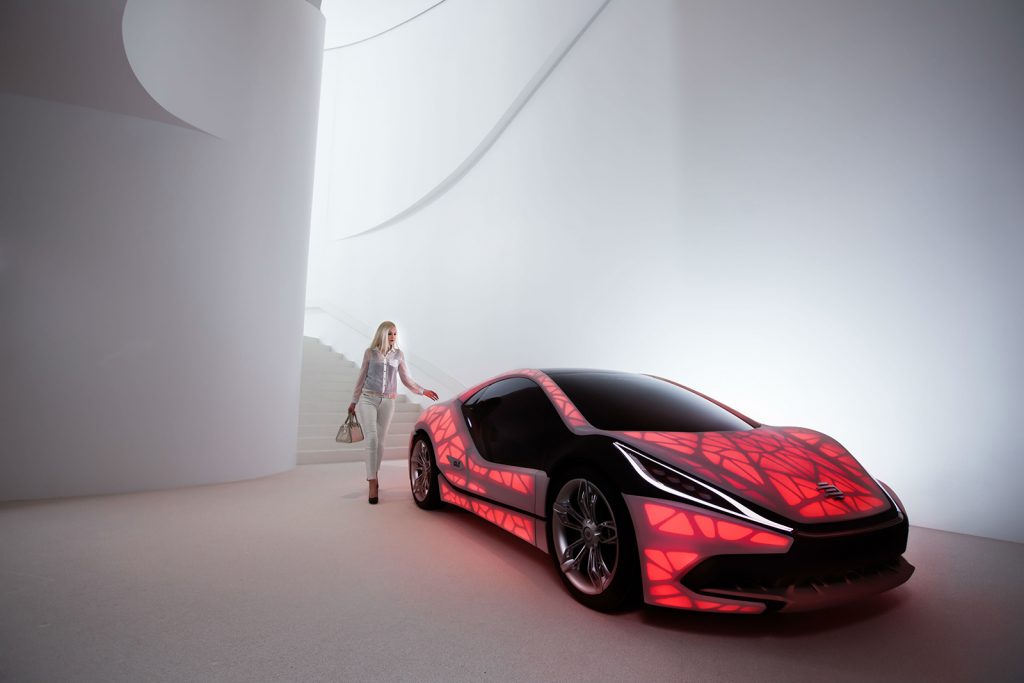
Automotive manufacturers are increasingly required to integrate a diverse range of drive types and energy storage systems into vehicle structures. The vehicle bodies of tomorrow will not only need to be lighter but will also require designs that are flexible enough in order to accommodate the large number of alternative drive systems, some of which may be produced in relatively low volumes. The consequence is an increasing number of vehicle derivatives which demand adaptable bodywork concepts that are economical to manufacture. In the foreseeable future, Additive Manufacturing could offer entirely new approaches.
One such approach is the EDAG Light Cocoon concept car, unveiled in March 2015 at the Geneva Motor Show and seen later that year at the International Motor Show (IAA) in Frankfurt (Fig. 1). The EDAG Light Cocoon concept is a compact sports car with a bionically designed and additively manufactured vehicle structure, covered with an outer skin made from weatherproof textile material. The intention with this vehicle was to trigger a debate among designers and break with conventional expectations of vehicle design and construction. The car’s creators state that the vehicle highlights sustainable production and at the same time embodies the technological potential of Additive Manufacturing.
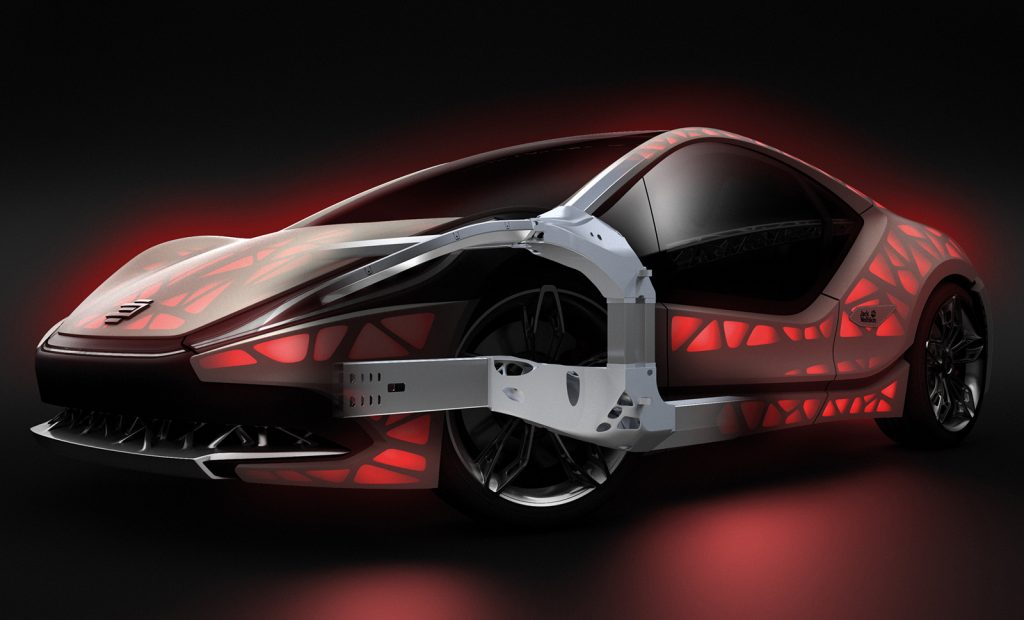
In a joint project, EDAG Engineering GmbH (Wiesbaden, Germany), Laser Zentrum Nord GmbH (Hamburg, Germany), Concept Laser GmbH (Lichtenfels, Germany) and the BLM Group (Cantù, Italy) created the bionically optimised spaceframe. This was produced by hybrid manufacturing to highlight one way in which car bodywork can be manufactured flexibly whilst at the same time accommodating the needs of an increasing range of different drive and performance requirements. Additively manufactured bodywork nodes and intelligently processed steel profiles are combined and, thanks to AM, the nodes can be configured to be highly flexible and multifunctional. In this way different versions of a vehicle can be produced on demand without any additional tooling, equipment and start-up costs. Steel profiles are used as connecting elements and these too can easily be adapted on an individual basis to the specified load levels by providing them with different wall thicknesses and geometries (Figs. 2 and 3).
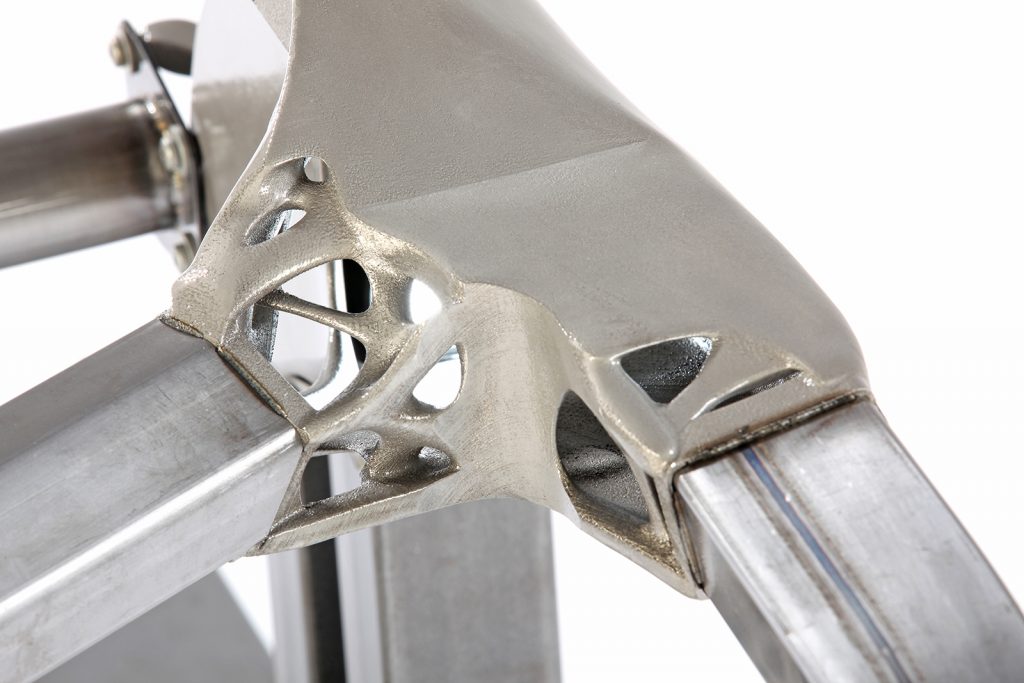
The NextGen spaceframe in detail
The nodes on the NextGen spaceframe can be manufactured on-site ‘just in sequence’ (JIS), along with the steel profiles, which are cut to the appropriate shape and length initially using 3D bending and then by employing 2D and 3D laser cutting processes.
The focus is on joining individual components to create a hybrid structure to produce topologically optimised spaceframes that are simply not possible using existing technology. Laser welding is used as the joining method, characterised by precisely welded seams and low thermal input. The profiles are automatically aligned and fixed in place by the node and a high-brightness laser with robot-guided optics is used to perform the welding. In addition, the laser techniques used to produce profiles and nodes can largely be automated in assembly. This offers great potential when it comes to the manufacturing cost structure and time required to manufacture.
The AM nodes can be adapted to reflect each load stage, for example by incorporating additional stiffening elements to cater for high load requirements. This means that each version is designed for optimum weight and function. Both the nodes and the profiles were optimised using CAE/CAD and guarantee the requirements that are demanded of a bodywork structure.
As well as playing a coordinating role, EDAG Engineering GmbH was responsible for devising and optimising the spaceframe concept, Laser Zentrum Nord GmbH undertook the laser welding, the BLM Group undertook the 3D bending and laser cutting and Concept Laser GmbH performed the Additive Manufacturing of the nodes. The project could only be implemented successfully thanks to the interdisciplinary collaboration between the complementary partners and the high level of expertise of the individual technology specialists in their specific disciplines.
Production of the Additive Manufacturing spaceframe nodes
Concept Laser’s powder bed laser melting process, LaserCUSING, was used for the production of the nodes. AM allows the production of components with complex geometrical shapes without the use of any tools and directly from 3D CAD data. With this type of design, the nodes cannot be manufactured by conventional steel casting. As with all parts produced by this process, support structures need to be provided on planes with an angle of less than 45° in relation to the build platform. As well as providing support, these structures also absorb internal stresses and prevent the components from warping. Because of the complex geometry of the nodes, good support preparation is essential for successful production. After generating the support structures, the component design is virtually ‘cut’ into individual slices. Once the data has been transferred to the LaserCUSING machine and the corresponding process parameters assigned, the build process is started.
The nodes were manufactured on a Concept Laser X line 1000R machine which has the necessary build envelope for such projects (630 x 400 x 500 mm) and operates with a 1 kW laser. The X line 2000R, also from Concept Laser, has a larger build envelope (800 x 400 x 500 mm) and is equipped with two 1 kW lasers (Fig. 4).
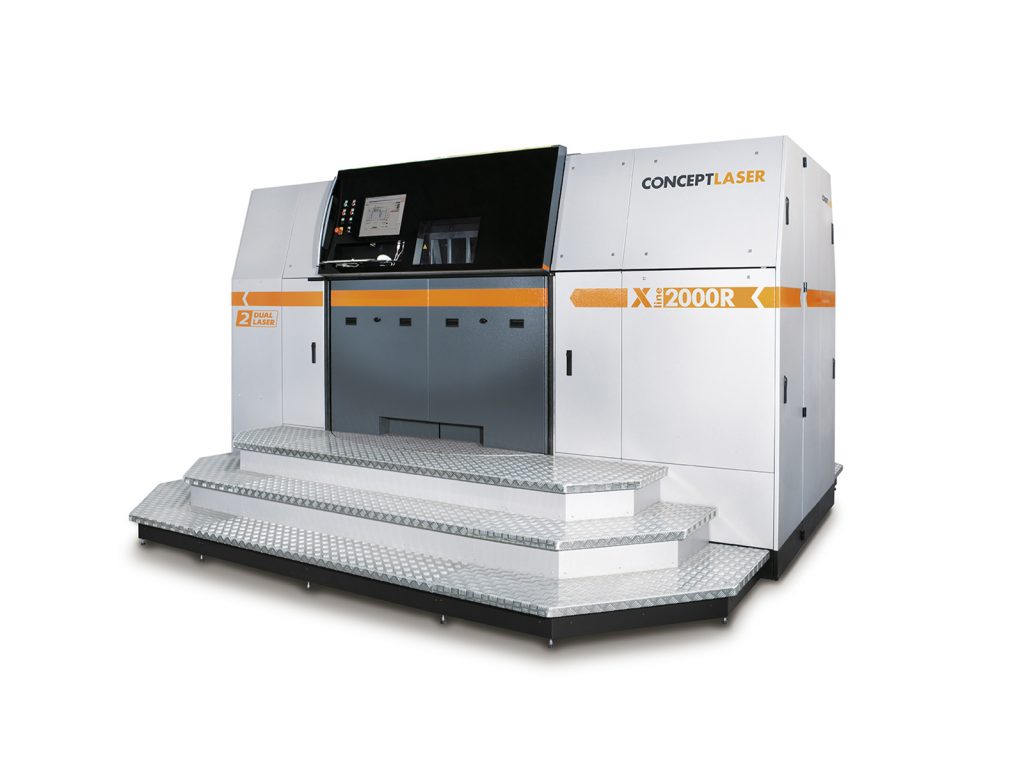
Digital 3D manufacturing strategy with laser technologies
The spaceframe concept combines the advantages of Additive Manufacturing, such as flexibility and the potential for lightweight construction, with the efficiency of proven conventional profile designs. The topologically optimised nodes enable the most efficient lightweight construction that is currently possible, as well as a high degree of functional integration.
Both the nodes and the profiles can be adapted to new geometries and load requirements without any additional outlay. This means that every single part can be designed to cater for a specific level of loading, rather than designing a single component to cope with the greatest load even if the majority of vehicle models do not demand it, as was previously the case. Nodes and profiles are therefore custom designed to reflect what a particular vehicle model requires, resulting in a spaceframe structure with an optimised load path. By employing processes which make limited use of tooling, it will be possible in the future to manufacture all bodywork versions of a vehicle economically and with the greatest possible flexibility.
Additive Manufacturing and the automotive industry: A broader view
The NextGen spaceframe system is just one example of how Additive Manufacturing has the potential to transform automotive production. Commenting on the challenge that the automotive sector faces in achieving sustainability targets, Dr.-Ing. Martin Hillebrecht (Fig. 5), Head of Competence Centre for Lightweight Design, Materials and Technologies, EDAG Engineering GmbH, stated, “Automotive manufacturers are under great pressure to develop vehicles which are due to go into production between now and 2020. The new bodywork structures should weigh less, have high stiffness to ensure outstanding performance and satisfy demanding load scenarios in the event of a crash. In spite of all the ambitious targets for weight reduction, greater demands from customers, thinking of alternative drives, comfort, functionality and networking, as well as new safety requirements from international legislators are sales criteria that do not favour lightweight construction. From my perspective, the core concept of a visionary and bionic spaceframe would be, among other things, only to use materials where they are really needed to deliver a function, safety or rigidity. So a reduced approach based on the motto less is more. Thanks to Additive Manufacturing and the profiling method with minimal use of tools, it may even be possible in future to design all bodywork versions to suit the level of loading and manufacture them ‘on demand’. Whatever happens, there is definitely potential here.”
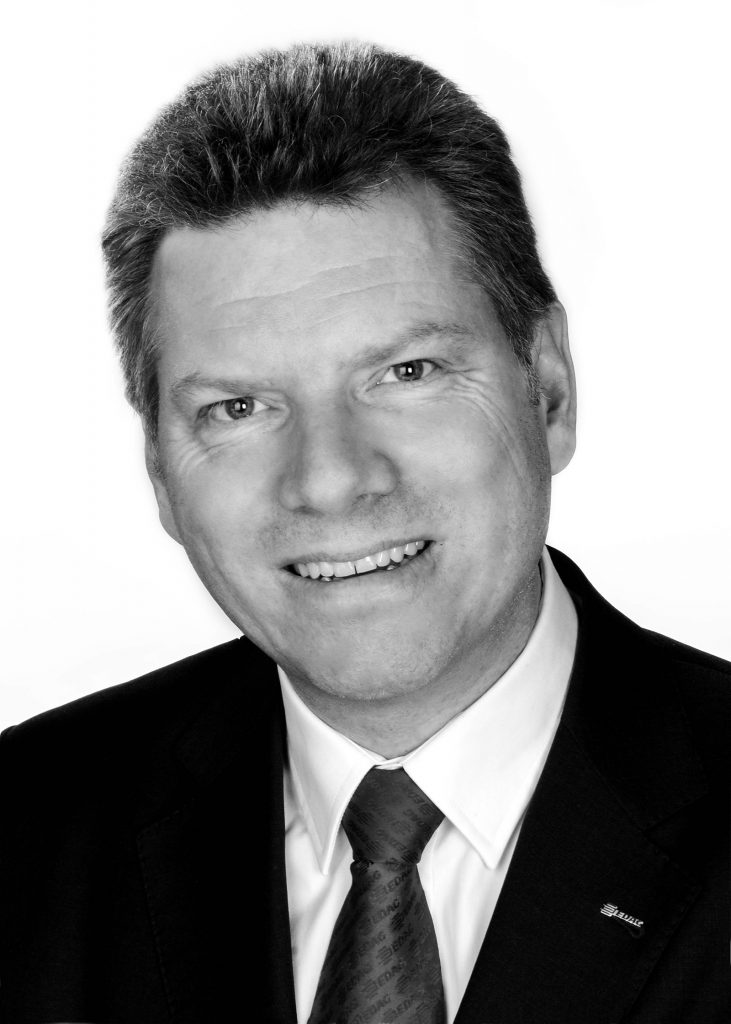
Sergio Raso (Fig. 6), Head of Strategic Marketing – Laser Products, BLM Group, commented on this theme, stating, “Sustainability is the overriding aim for the automotive industry. Various core technologies for the future of automotive production have so far been looked at. The frame structure of the EDAG Light Cocoon combines many of these technologies in one approach. For example, there is a lightweight hybrid design to achieve weight reduction and fuel efficiency, the use of additive methods for a bionically optimised design and the use of tubing and profiles to ensure that the vehicle frame can be manufactured in a highly flexible way.”
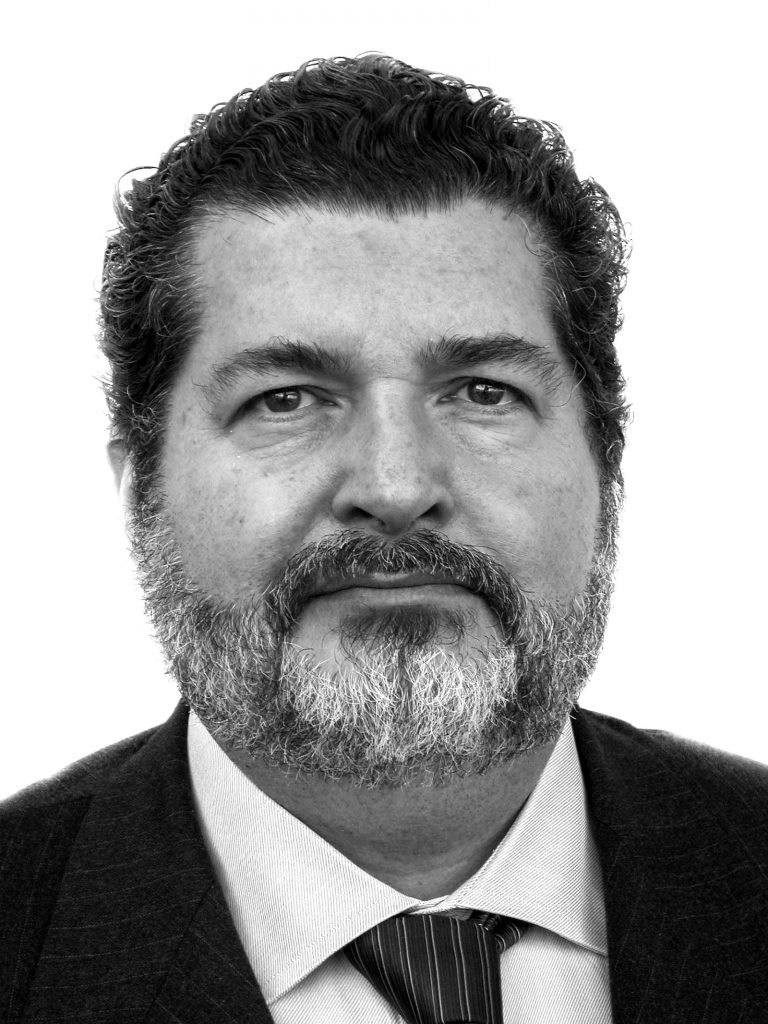
Encouraging the adoption of new automotive concepts
As the example of electric vehicles demonstrates, it takes a long period of time to progress from initial innovative concepts to volume production. Automotive pioneers such as Hayek with the original Smart car, or Tesla Motors, are examples of how it can be challenging for innovation to be accepted. Commenting on whether the automotive industry is really ready to look at its products in completely new ways, Hillebrecht stated, “Experience shows that one possible way to embark on new manufacturing strategies such as lightweight design is often to produce small numbers of vehicles in the luxury and supercar segment. This clientele identifies with lightweight design, e-mobility and technical innovations much more than the mass market. These ‘innovators’ are willing to accept much higher manufacturing costs as a price worth paying for better driving dynamics, comfort, safety and for ecological reasons. If the technology shows suitable potential and as its development advances to allow mass automotive production, the processes can then be scaled up from a niche product to enable larger volumes to be produced. But this definitely requires a degree of patience, long-term investments in the future of the companies involved and a great deal of technical expertise. I don’t accept that a long period of time is required, but it definitely takes some time to adapt new technologies.”
Raso added, “In the automotive industry, the number of jobs depends to a large degree on the manufacturing methods and strategy employed. They have a crucial bearing on the cost structures, the achievable margins and the level of success. These factors shape the way we look at mobility and not least also the prosperity of many national economies. In order to maintain the level of automotive mobility that has been achieved, the automotive industry has continuously invested in making technological advancements to its automobiles and the production processes behind them. Investments in research and development are essential, and we at the BLM Group are also on this path of innovation and ongoing development.”
Green technologies in the automotive sector
The conservation of resources and the use of green technologies are today important considerations in any industry. Commenting on how automotive manufacturers view this, Hillebrecht stated, “Thanks to smart lightweight design, particularly with composite construction, vehicles should be roughly 100 kg lighter than their predecessors, depending on the segment of the market. A further weight saving of 10 to 20% can be achieved in the bodywork and add-on parts. Many manufacturers have already succeeded in reversing the spiralling trend for increased weight. It is a balancing act that we are trying to achieve.”
Raso believes that solutions for green technologies and intelligent energy management are heavily dependent on action by governments, with their political targets, laws and definitely also the incentives that they provide. He stated, “This focus, if we just look at the US state of California, is an increasingly prevalent fact that we must come to terms with. Automotive manufacturers are accepting these demands and also view political targets as an engine for driving innovation. So politicians and manufacturers share a common interest. Along with the known solutions for energy management, such as developing electric storage units and drives and also vehicles equipped with fuel cells, the manufacturing processes can also be heavily geared to reflect the visions of green technology. The manufacturing design with all-electric bending machines, laser cutting machines with a high level of efficiency or laser melting are examples of how the BLM Group is committed to a greener future. The path toward intelligent conservation of resources and sustainability is an irreversible mega trend. All of the stakeholders in the automotive industry are conscious of this.”
The disadvantages of traditional body design
The development of the NextGen spaceframe serves to highlight the advantages and disadvantages of conventional car body designs. Today’s car bodies are intelligent, load-optimised and crash-optimised structures whose material and design concepts have achieved a high level of maturity, both in terms of lightweight design and passenger protection. Prof. Dr.-Ing. Claus Emmelmann (Fig. 7), CEO, Laser Zentrum Nord GmbH, stated of the project, “The traditional tool-based manufacturing methods which are used are reaching their limits in terms of flexibility and feasibility. Laser Zentrum Nord was able to work with its project partners to overcome these limits conceptually with the bionic design principles modelled on nature. The spaceframe concept attempts to highlight what is possible beyond the current limits with regard to products, manufacturing and automation.”
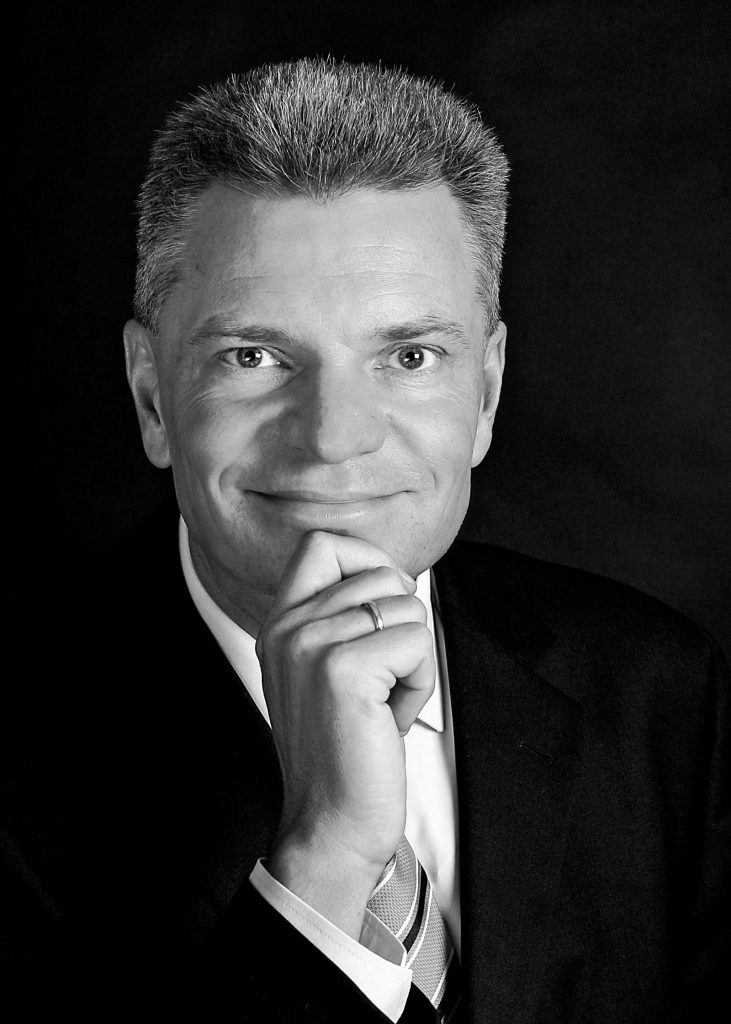
Hillebrecht stated, “In a typical car body with a monocoque construction, panels, reinforcements, mounting plates and profiles are connected together using joining technology. All components act as shells. The required rigidity is produced by cross-sections of metal sheets. The advantage of this design is the low manufacturing cost associated with industrial mass production, which is the same worldwide. As well as inexpensive semi-finished products made from sheet metal, tried-and-tested and robust technologies such as forming and spot welding are used. The disadvantage here is that tooling and plant investments only make economic sense if there are large quantities and make it difficult to produce a wide variety of different versions. In addition, tool-specific parts are associated with tooling costs and periods of preparation for the tooling technology are required. Ultimately, the tools have to be available across the full life cycle of the product. The spaceframe design consists of closed hollow profiles which are linked together by nodes. Flat components such as the roof absorb the shear forces. In future, a spaceframe concept will enable new materials to be used. This will need to be investigated. But in general it is already the case today that the concept enables the manufacturer to achieve a significant weight saving and high torsional stiffness along with a high level of economic efficiency for vehicles produced in fairly small numbers.”
Raso added, “A major advantage of the conventional structures for vehicle frames is the interplay between consolidated technologies which are available now for manufacturing and assembling the frame. Currently production lines must generally include various processes and phases prior to the final assembly of the vehicle frame. The disadvantage of this concept is the outlay and the limited flexibility in the assembly workflow. New ideas and, derived from them, economical and flexible concepts for future manufacturing are required here. I would put it this way: There are major challenges.”
Unique features of the NextGen spaceframe
The NextGen spaceframe combines additively manufactured nodes with steel profiles in a hybrid design. Hillebrecht explained, “This approach promises to make production extremely flexible and it promises the possibility of a wide range of different versions without having to spend any money on making further investments in apparatus, tools and plant technology for each version of a vehicle. I think that a wide range of different models may emerge because restrictive cost barriers will no longer apply. In addition, Additive Manufacturing allows the greatest possible resource efficiency with regard to the materials that are used. Moreover, this process yields bionic structures with optimised load paths whose geometry means they simply cannot be produced using other manufacturing methods.”
Emmelmann stated that the spaceframe concept combines the advantages of Additive Manufacturing, such as flexibility and the potential for lightweight construction, with the efficiency of a proven conventional profile design. “The laser plays the key role in both technologies. The bionically optimised nodes enable the maximum lightweight construction that is possible at the present time, and a high degree of functional integration. Both the nodes and the profiles can be adapted to new geometries and load requirements without any additional outlay. This means that they offer the possibility of designing every single part to cater for the level of loading, and not dimensioning the components to reflect the greatest motorisation, as was previously the case. The basic idea then is to have a frame design which can be optimally customised to reflect what the particular model requires.”
A key feature of the NextGen spaceframe concept is the consistent focus on keeping the manufacturing and assembly processes extremely flexible. Raso stated, “Additively manufactured free-form nodes enable new design solutions and a large number of different varieties of models. The incorporation of bionic structures, a hollow design or lattice structures allows the frame to display optimised mechanical properties. The integration of force absorption characteristics in the profiles and nodes permits controlled deformation of the frame and delivers increased safety for passengers. The inclusion of AM and configuration of interfaces for laser welding optimises the manufacturing process. So firstly flexibility, secondly safety and thirdly simplification of processes are just a few examples of the advantages of this approach.”
Frank Herzog (Fig. 8), President & CEO, Concept Laser GmbH, believes that hybrid construction is already being used in other sectors. “Relatively simple or excessively long geometries, such as the profiles used here, are produced by traditional machining, and more complex geometries are then manufactured additively. This phenomenon reflects the economics. Composite construction is of interest in many sectors where there is a need to bridge a gap between function and economic efficiency,” he stated.
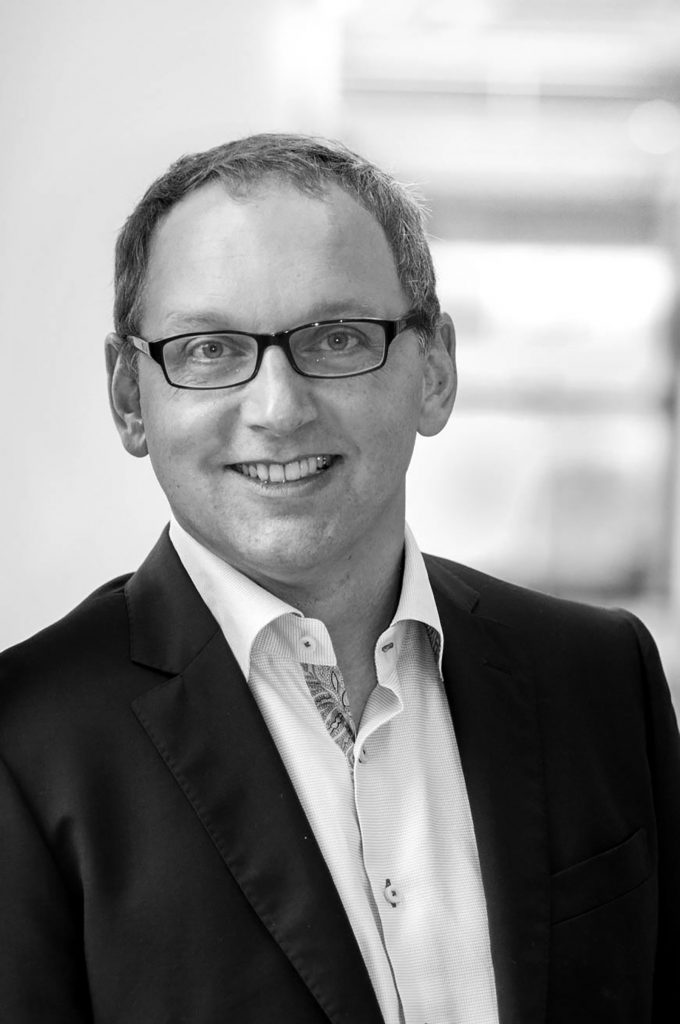
Using bionic design and hybrid construction to enable lightweight design
The potential for hybrid construction lies in flexible design that caters for specific load situations, along with the opportunity to use bionic structures to maximise lightweight design on a scale that was previously unimaginable. Emmelmann stated, “At Laser Zentrum Nord we develop design guidelines to be able to successfully transform bionic prototypes such as a bamboo structure or bird-bone structure into such sophisticated technical lightweight components with weight savings of between 30 and 50%. Bionic design, which is possible thanks to Additive Manufacturing, provides numerous options. Manufacturing benefits from these new manufacturing processes in many ways: it is not just that the costly tools are no longer required, but flexible small batches or even modifications to components within the life cycle of a model can be produced instantly without any additional outlay.”
Hillebrecht added, “In addition, the ability to respond to fluctuations in sales volumes and ‘updateable’ components during the life cycle of a vehicle in the sense of Industry 4.0 should be emphasised. These are completely new ideas for the industry. We are very excited to see how our customers will react to this.”
Raso believes that the new concept means great freedom of design for developers and designers. “The proposed concept provides the designers in the automotive industry with more lightweight solutions, more ecological approaches and improved safety solutions. In manufacturing, the adaptation of laser-based methods, such as Additive Manufacturing of nodes, laser cutting and laser welding of tubes and profiles, means an unparalleled degree of flexibility. Not least, these manufacturing strategies may help to increase the level of automation. These methods represent the innovation of manufacturing processes.”
Industry 4.0, or the fourth industrial revolution, is a collective term embracing a number of contemporary automation, data exchange and manufacturing technologies. Herzog believes that the core aspects of this concept play a fundamental role in Concept Laser’s recently presented AM Factory of Tomorrow (Fig. 9). “The objective is to automate and thus minimise manual processes in order to prevent any downtime in the production of components. Any desired number of machines which were previously designed to be stand-alone solutions will increasingly be linked together to embrace the notion of a smart factory. There will also be automation and interlinking of additive and conventional technologies, in particular in the reworking of the components that are produced. Traditional manufacturing methods will then operate alongside additive methods. Our AM Factory of Tomorrow is aligned with the requirements of the basic idea behind Industry 4.0 and in the future will also make our process economically attractive for the mass production of metallic components. This will then undoubtedly also apply to the automotive industry where it is primarily all about large volumes and quantities.”
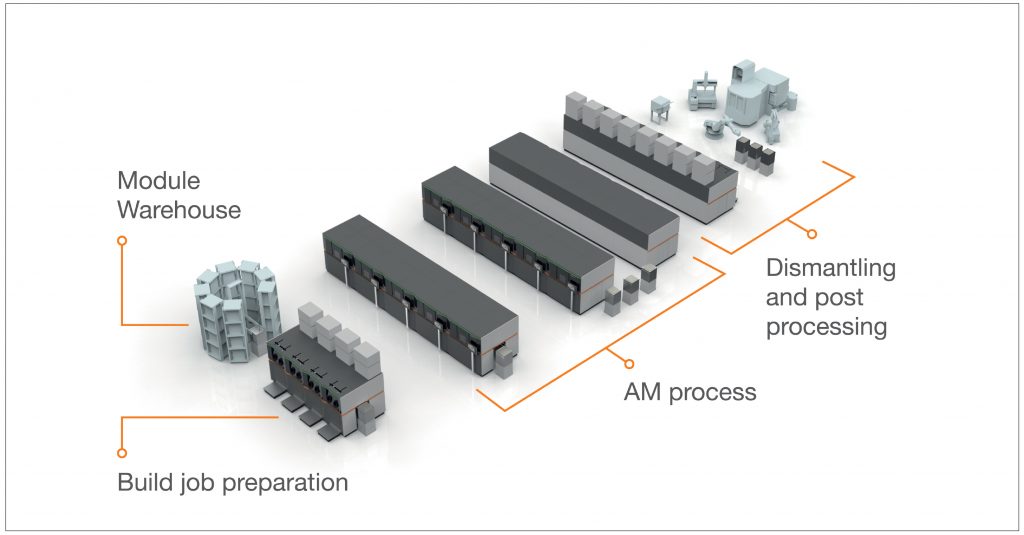
Metal AM’s future impact on the automotive industry
It is now almost impossible to imagine prototyping in the automotive industry without metal Additive Manufacturing. The technology makes it possible to produce fully resilient trial parts quickly and without the high tooling costs that are otherwise customary. However, the move to mass production has not happened yet. Emmelmann stated, “The continuous increase in the productivity of Additive Manufacturing machine technology means that this step will be made in the next five to ten years. The two projects which were presented at the IAA trade show in 2015, the bionic spaceframe and the housing for power electronics, demonstrated two specific ways in which this technology may shortly be employed economically in electric mobility vehicles or even other vehicles produced in low volumes.”
Raso commented, “Additive Manufacturing techniques are today employed primarily in the automotive industry to manufacture small numbers of functional parts. However, as the aerospace industry has already demonstrated, we can see that the move over to Additive Manufacturing strategies significantly enhances product and process performance. The introduction of the ‘Manufacturing for Functionality’ paradigm instead of the rather restrictive ‘Design for Manufacturing’ as well as ‘just-in-time manufacturing’ and precision concepts have already begun to establish a foothold in the automotive industry. We are seeing the foundations of something completely new here.”
Hillebrecht believes that the additive processes provide great potential in prototyping and tooling and the production of spare parts. “These processes have so far not caught on in automobile production. This is undoubtedly also due to the high prices of materials and machine technologies. We await the future with keen interest. We would be delighted if the sector were to embrace our ideas of tool-free manufacturing in combination with traditional manufacturing methods. There are definitely lots of opportunities here.”
Herzog summarised the situation, stating that the level of interest will increase as the level of Additive Manufacturing technology advances. “A high level of acceptance in the automotive industry can of course only be expected if, as in the aerospace sector, the new design possibilities that Additive Manufacturing brings are embraced. Simply substituting parts made using traditional methods delivers few advantages. It is all about having a design to suit the method – and these parts then look different, are lighter and are often probably also more capable.”
Changing design and project workflows for automotive components
The AM process development chain, including specification and topology analysis, the development of functions, bionic design and production-oriented design is currently very limited and time consuming. Hillebrecht stated, “CAD and CAE will increasingly merge together. Overarching CAx competence will be demanded. In addition, we require bionic components and tools, not least a working interface with the laser melting machine, so that ‘anything imaginable’ really could then be printed.”
Raso believes that the use of 3D-bent and laser-cut tubes and profiles for structural assembly has already proved to be a way of saving weight in assembly while still retaining the mechanical properties. “In this design, the load-specific matching of laser-melted 3D nodes and laser-welded 3D profiles has an important role to play. Nodes produced by traditional casting technologies proved to be a trusted solution in the past. Thanks to bionics, hollow spaces and lattice structures, Additive Manufacturing now allows the 3D nodes to have even more options for design, variations and safety aspects. I see this as an important next step,” he explained.
The safety limits of bionic AM designs
The Nexgen spaceframe concept serves to highlight some clear advantages for safety-relevant components. In the case of an accident, the functional design of the profiles and nodes ensures controlled deformation of the frame. Simulations have already shown that the interaction between nodes, cross members and longitudinal beams significantly improves performance under crash conditions. The dissipation of mechanical or kinematic energy is far better compared to a conventional frame structure.
Hillebrecht commented, “In the case of components which are stressed in a crash, for example the longitudinal beams and A-pillar nodes, energy is dissipated away by a ‘defined buckling’ of the beam. A corresponding CAE method for optimising the crash performance of bionic components has recently become a new and exciting topic for research and development. In addition, the range of materials on offer for use in Additive Manufacturing has not previously been matched to the requirements of automotive manufacturers. We are frequently asked to provide support and practical help here. Additive strategies change everything; structures, functions, choice of materials – and the possible range of quality and services.”
Emmelmann believes that bionically optimised metal AM parts are on a par with conventional components when it comes to component strength. “The material and component properties can be adjusted to specific applications through targeted after-treatment of the component, for example sandblasting or thermal treatments. Essentially, it is now possible for the first time to ‘design’ performance characteristics in a convincing way. At Laser Zentrum Nord, the employees working in the area of research and development are engaged among other things with the issues of component optimisation, process qualification, quality assurance and also the calculation and targeted modification of key material parameters. Bionic optimisation offers the opportunity to use the material in an optimum way that reflects the load situation and thus implement maximum lightweight design,” he stated.
Overcoming the automotive industry’s reliance on volume and common platforms
The automotive industry is volume-driven and thinks in terms of high quantities and platform strategies in order to manage costs, making it challenging for a concept such as the NextGen spaceframe to overcome these traditional attitudes. Raso stated, “It is difficult to believe that this new hybrid lightweight design can lead to an immediate sweeping innovation in the mass production of frames for cars. A more realistic scenario is that the new concept will be adopted for small batches of high-value automobiles while alongside this traditional design paradigms are retained for low-cost mass production. A best of both worlds mindset could become established. That would be realistic in my view.”
Hillebrecht agrees that this project isn’t currently appropriate for the cost-minimised production of a global mass product. “The appeal is of course also to consistently utilise enhanced functions and automation. I am also convinced that a consistent concept can only emerge if a large number of electric and non-electric alternative drives for vehicles also come into play as a general requirement. After all, the theme is only really just developing,” he stated.
Herzog summarised stating, “Experience shows that innovations in the automotive sector first emerge in the premium segment. We only need to think about things like the airbag, LED lights or ABS. An innovation then gradually works its way down the product range. There are economies of scale here which have a positive effect on costs. If we assume that the costs of a kilogram of laser-melted products will fall over the long term due to technical progress, then the issue of Additive Manufacturing becomes more and more interesting to those in the automotive industry. According to the experts from Roland Berger, in 2012 the average price including all of the AM processing costs, so for machine technology, powder, energy costs, reworking, etc., was around €3.14 per cm³. These analysts predict a price of around €1.60 per cm³ by 2018 and €1.10 per cm³ has been estimated for 2023. All I want to say here is that there is probably a clear trend illustrating that there will be plenty of movement on the cost side.”
Additive Manufacturing and the spare parts supply chain: a realistic proposition?
Spare parts for cars are regarded as a logistical and costly challenge. Global availability, warehousing, life cycles and the pressure of time are all challenges for the spare parts experts. Not least, spare parts are currently a blessing for automotive suppliers that operate as OEMs or retrofitters or even duplicators. Commenting on how Additive Manufacturing could change this situation, Hillebrecht stated, “Additive Manufacturing makes it possible above all to fabricate components at different locations. This means that local advantages can be exploited, and different versions can be produced later and close to production. There are thus no transports and logistics costs, different versions of components no longer need to be kept in stock and production close to the market and customers shortens the delivery time.”
Emmelmann added, “Additive Manufacturing means that it is no longer necessary to send physical components around the world, but instead simply send CAD data records and then, if necessary, print out spare parts at a local level. One option is to have decentralised manufacturing, the effects of which we can only imagine. This approach will radically alter the supply of spare parts; delivery times will be reduced significantly and warehousing costs will be completely removed. This scenario is currently being actively implemented with the aviation industry. The foundation is thus being laid for this approach to be transferred to the automotive industry too.”
Raso suggests that car frames based on the NextGen concept will also enable new paradigms for the management of spare parts and their logistics. “Fully automatic production of profiles and nodes based on just-in-time approaches would enable a drastic reduction in costs, also assuming that new guidelines for the repair of vehicles will be adopted,” he stated.
AM strategies for vehicles in the future
Hillebrecht states that Additive Manufacturing processes will move away from the traditional areas of application such as rapid prototyping, instead operating alongside the traditional manufacturing processes and offering a new dimension to the possibilities of constructive design. “For me this is in fact radical. Additive Manufacturing will make it possible to create very complex, functionally integrated and highly efficient structures that cannot be produced using other methods. It will therefore be possible in future to design complex components with a customised design for products available in lots of different versions, and manufacture them individually on demand without the use of tools to ensure optimum function, safety and weight. This is fundamentally new in the industry,” he explained.
Herzog shared this assessment in the medium term, stating, “I also think that it must be clear that when it comes to design, as with the NextGen spaceframe, we will have to adopt completely new approaches to implement Additive Manufacturing more strongly in the automotive sector. The integration of functions, such as cooling capacity, may also be an important piece in the jigsaw. An additively manufactured product must be consistently developed starting from the performance criteria. If it can do more than the old product and also deliver lower costs and greater flexibility, it will appeal to people.”
The impact of metal Additive Manufacturing on new model development and vehicle cost
Commenting on whether these new approaches will be able to invigorate the development cycles, the range of models and their costs, Raso stated, “The great flexibility of the spaceframe design enables parametric construction of the car frame. In principle, we are pushing open a window for a much wider range of models or even personalised cars. What I am certain of is that the cost structure can be approved with this strategic approach and therefore hopefully also lower the final costs of the vehicle for the purchaser.”
To a great extent the potential of this technology depends on the future direction of the automotive industry. Will volume strategies dominate or will there be a demand in the future for individualised car concepts in order to attract purchasers? “In the latter scenario, and it is possible that both trends will exist side by side, Additive Manufacturing will be able to lead the way in some respects,” commented Herzog.
AM also offers the possibility in future automotive components for functional integration, such as cooling functions, or the ability to construct more powerful and capable components. Hillebrecht regards this as essential to justify the higher costs of AM components, stating, “Without this functional added value, which I take for granted in any concept, no matter which one, it will scarcely be possible to justify the currently high Additive Manufacturing costs.”
Are current build volumes holding back Additive Manufacturing in the automotive sector?
Current build envelope limits and assembly speeds in powder-bed metal AM present limitations on the use of the technology in the automotive industry. Commenting on this, Emmelmann stated, “At the present time, the productivity of the process for certain applications, such as large-scale automotive production, is limited. To that extent, the argument is correct. In sectors such as medical technology or aviation, the process is already heavily used. I forecast that the technology will see a significant leap in productivity over the coming years and thus will also manage to gradually become an attractive proposition for large-scale automotive manufacturing. Laser Zentrum Nord works together closely with its partners to develop new machine and automation concepts designed to make this possible.”
Hillebrecht stated, “The build envelopes are already more or less sufficient today, but typical materials are still not adequately developed and are much too expensive. We would like to see Additive Manufacturing processes which enable an assembly speed that is maybe 100 times greater while still retaining the same surface quality.”
Raso believes that restrictions in terms of the build envelope and prices will be reduced in the near future thanks to the introduction of new laser systems for Additive Manufacturing with greater power and enhanced build rates. However, he stated that the hybrid design of the spaceframe featured in this article with nodes and profiles has been adopted for longer dimensions and already gives a hint of an economical approach today.
From a machine maker’s perspective, Herzog stated, “Let’s take a look back and a look ahead. The assembly speeds have already increased a great deal thanks to multilaser technology and increasing laser power. But it should also be borne in mind that each new laser source increases the complexity of the process and therefore also its susceptibility to errors. From today’s point of view, I do not think that purely quantitative approaches are the best way to go. As we demonstrate with our AM Factory of Tomorrow, from our perspective the vital thing is to focus on downtimes during the production process with the ultimate aim of minimising them. They are usually associated with manual tasks in upstream and downstream stages of the process, such as supplying new powder or finishing the products. This is where in the first instance we see a much more important starting point for advancing our process to make it viable for economic mass production, even if the laser power certainly still offers plenty of scope to be increased.”
“In addition, qualitative efforts are paramount for us because an additively manufactured product should of course also be able to win people over just in terms of its quality. If this basis is easy to control, progress can be made when it comes to performance. I would like to support the comment made by Dr Hillebrecht that the build envelopes are already large enough. Even larger parts may perhaps be possible, but with very large parts we start to reach the limits of physics: The stresses in the part would increase. This cannot be controlled by procedures today. One alternative is then always to use joining techniques in order, for example, to join together very narrow, long parts in a modular fashion. Despite all the euphoria surrounding Additive Manufacturing, we would be well advised to look to the future with realism and a sense of proportion,” stated Herzog.
Outlook
Standards for the Additive Manufacturing industry and quality requirements are being drawn up by industry experts and will inevitably be based on the standards used for traditional manufacturing methods. Herzog commented, “We have a more or less ‘blank canvas’ as far as the Additive Manufacturing solutions of the future are concerned. But the NextGen spaceframe sends a sufficiently bold signal to the automotive industry to look at the issue more closely in terms of design. Maybe I see things too cautiously, but what we need in the future is a ‘3D generation’, engineers and designers who are confident working with Additive Manufacturing, because young people today can barely imagine a life without their smartphone or the internet. The 3D generation is certainly still in its infancy, but it also needs specific projects in order to prove itself. However, I am confident that this 3D generation will search for its own themes.”
Raso believes that metal Additive Manufacturing has become established worldwide as a reliable technology. “From my point of view, it is better able to guarantee quality levels of the process and products than traditional manufacturing solutions. In this scenario, Additive Manufacturing processes are expected to take us to an even higher level of quality. Based on the digital process, the technology will be very capable of being integrated into digital production in the future. Along with the theme of automation, there is plenty of interesting potential for Industry 4.0 here,” he stated.
Contact
Daniel Hund
Head of Global Marketing & Communications
Concept Laser GmbH
An der Zeil 8
96215 Lichtenfels
Germany
Tel: +49 9571 1679 251
Tel: +49 9571 1679 299
Email: [email protected]
www.concept-laser.de







